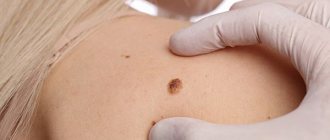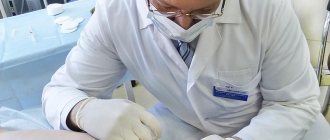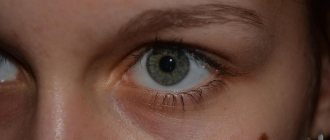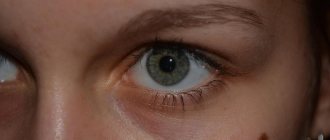Almost every owner of a mole that rises above the level of the skin has encountered unpleasant sensations in the area where it is located.
More often this is due to trauma.
Especially if the mole is located on an area of the body that is often subject to friction from clothing.
For example, in the collar area or on the back.
In some cases, a mole hurts due to other reasons not related to injury.
There is a change in its appearance, which can become symptoms of the degeneration of a benign process into a malignant one.
A mole (nevus) is a pigmented neoplasm that appears on the skin from birth or throughout life.
It has various shades (brown, red, blue, purple and others).
Moles are formed when pigment accumulates in the skin.
In increased quantities, it turns into melanocytes and forms moles.
These tumors in normal condition do not cause pain or discomfort.
But under certain conditions and under the influence of certain factors, pain occurs in a state of calm or when pressing a mole.
This may be a consequence of inflammatory processes or hormonal disorders.
In any case, you should consult a qualified healthcare professional.
Since in some situations it may be necessary to remove the disturbing tumor.
Why does a mole hurt?
There are several main reasons why a mole hurts.
Most often, pain occurs as a result of injury.
This is also accompanied by minor bleeding, swelling and hyperemia of the surrounding soft tissue.
If the mole hurts and itches, and new nevi appear, hormonal changes are suspected.
This occurs more often in women during pregnancy.
Painful moles are caused by the following reasons:
- Injuries - a hanging mole in particular often hurts, which can easily be touched by clothing, a washcloth or jewelry, depending on its location. But other types of moles can also be injured, sometimes this happens in beauty salons when performing intense massage, using anti-cellulite cups, or performing depilation. More often, nevi located in the armpits, pubis, collar area, and on the folds of the lower and upper extremities are injured. Often the cause of pain is an injury to a mole while using a razor. Any damage to a benign formation should not be ignored, since even minor scratching can provoke malignancy, which poses a direct threat to human life.
- Increase in size - the cause of such changes is often hormonal changes, but sometimes the mole grows and hurts when the process becomes malignant.
- Prolonged exposure to direct sunlight or staying in a solarium leads to burns. In this case, the mole hurts and may itch, but after 3-5 days the discomfort goes away on its own. If after being under the hot sun the pain does not disappear for 7 or more days, you should see a doctor and undergo an examination, the process of malignancy (malignancy) may have begun.
- Inflammatory processes - most often occur when a mole is damaged and infection enters, which causes hyperemia, pain and even swelling.
- Thermal burn of the skin - exposure to hot steam or liquid, fire, high temperatures causes burns of varying degrees of severity, the most sensitive areas are moles and age spots, where increased pain is felt.
- Hypothermia or overheating of the body - with any deviations in body temperature from the norm increases the sensitivity of the skin. Not only existing nevi can hurt, but also the site of a mole removed in the recent past.
Symptoms
The following signs are characteristic of the neoplasm:
- red, purple, burgundy, bluish tint;
- a change in color is more often characteristic of a malignant process;
- usually this is a single formation, if they gradually increase in size and spread more and more throughout the body, contact a dermatologist (this is a sign of vascular pathologies);
- complete absence of discomfort.
The mole should not itch, hurt or itch. If these signs occur, it is most likely not an angioma.
Signs of malignant degeneration of a mole
How to assess the danger if a mole hurts and determine the need for surgical intervention?
Unpleasant sensations can be the first symptoms of malignant degeneration.
How quickly and rapidly malignancy occurs depends on several factors.
For example, frequent exposure to sunlight significantly accelerates the process of malignancy.
Therefore, it is very important to periodically examine pendulous or other moles located in areas of increased trauma.
If any pathological changes are detected, you should consult a doctor.
Signs of malignancy:
- violation of symmetry (all benign moles are completely symmetrical, with the exception of congenital ones)
- uneven contours (malignant nevi are characterized by blurred contours and unclear edges; in a healthy state, a mole has clear contours and smooth edges)
- change in color (if dots, stripes appear on a mole, or it becomes multi-colored, this indicates its malignancy)
- increase in size (in a normal state, this is possible in adolescence or in women during pregnancy; in other cases, a sharp, causeless growth of benign formations requires examination and, in most cases, removal)
- any pathological changes (the occurrence of bleeding, cracks or the formation of crusts for no particular reason are the causes of degeneration)
In some cases, additional symptoms of malignancy of the process may include:
- swelling and pain of a mole
- peeling
- thickening of the tumor
- a feeling of burning and itching, periodic tingling in the area where the mole is located
- causeless formation of rashes around the nevus, similar to an allergic rash
Sometimes a mole hurts after removal, which can also mean the development of a cancerous process or the growth of a new benign nevus.
More often this is due to incomplete excision of melanocytes, cells that accumulate as moles.
Why does the process of malignancy of moles occur?
Any changes in the functioning of the body require consultation and examination by a qualified specialist.
It is very important to undergo diagnostics for timely detection of cancer and factors that provoke malignancy.
First of all, direct sunlight has a bad effect not only on moles, but also on the skin in general.
The aggressiveness of ultraviolet radiation leads to the development of cancer processes quite quickly.
It is no less dangerous to scratch the areas where moles are located.
Any damage to their integrity can trigger the process of degeneration or cause the introduction of an infectious pathogen.
Also, in areas where moles rise above the surface of the skin, you should not use hard washcloths.
Because there is a high risk of damage.
Prevention of angiomas
Prevention measures are of great importance for skin health. Of course, it is impossible to guarantee the appearance of red moles. But you can significantly reduce the risks of their growth. For this, dermatologists recommend:
- limit your time in the sun, avoid visiting the solarium;
- improve your diet, include more vegetables and fruits;
- quality rest;
- engage in moderate physical activity;
Be sure to visit a dermatologist as a preventative measure. When new growths appear on the skin, monitor its development. If the tumor is damaged or changes, consult a doctor immediately.
What does a dermato-oncologist do?
The specialist studies nevi and prescribes tests to determine the nature of the neoplasm.
Conducts differential diagnostics, assesses the likelihood of transforming a benign process into a malignant one.
First, a visual inspection is carried out.
Then specialized equipment is used for a more detailed study - a dermatoscope.
If there are risks of malignancy or the process of malignancy has already started, surgical intervention is prescribed.
The operation is performed by a surgeon using general or local anesthesia.
Mole removal methods
If a mole has enlarged and hurts for no apparent reason, as well as if there are pathological changes in its structural structure, its removal is prescribed.
If the development of melanoma is suspected, a surgical method is used.
During the operation, not only the mole itself is excised, but also the healthy tissue surrounding it.
The disadvantage of this procedure is the formation of postoperative scars.
This is due to the need to remove the neoplasm together with adjacent structures, the diameter of which should be at least 3-5 cm.
After the operation, the removed material is sent for histological analysis.
The use of liquid nitrogen at low temperatures – cryodestruction.
This technique is often prescribed to remove birthmarks that are at the level of the skin and represent a cosmetic defect.
During the procedure, the nevus is frozen, after which it shrinks and a crust is formed, which prevents infection.
Over time, the crust falls off and healthy structures are regenerated in its place.
Sometimes, if melanocytes are not completely eliminated, a repeat procedure may be required.
Since there is a high probability of relapse.
Moles that rise above the surface of the skin are sometimes cauterized using a needle electrode.
As a rule, the removed tumor is sent for histological examination to determine its nature.
After the procedure, a crust forms; after a while, an almost imperceptible scar may remain.
Removal of a nevus using laser radiation is considered one of the most effective and least traumatic operations.
Used to remove benign formations located on open areas of the skin, for example, on the face.
Laser equipment is highly accurate due to which the surrounding healthy tissue remains undamaged.
When eliminating small moles after restoration of tissue structures, there are no scars or scars.
Radiosurgery is also used to remove tumors protruding above the surface of the skin.
The technique is based on the influence of radio frequency waves, is the safest and completely non-contact.
After the procedure, the adjacent tissues with the surgical field are restored quite quickly.
Good equipment allows you to make cuts of various depths and any configuration.
Treatment of angiomas with laser
Laser removal of red moles is a safe, high-speed, painless and bloodless way to get rid of pathology. The method is suitable for children and adults. The doctor uses a laser beam of a certain intensity to burn out the growth “at the root.” This method has a number of advantages over other methods:
- short rehabilitation period, since the wound is disinfected with a laser;
- bloodlessness, because the vessels are immediately cauterized, which is especially important for vascular tumors;
- painlessness, since pain receptors do not have time to react to short impulses;
- no scars, since only pathological tissue is burned out and healthy cells are not affected;
- there is no risk of relapse, since the formation is completely removed.
It is enough to look at photos of the skin before and after surgery to understand that the laser method is the best method today to combat any skin pathologies. The red mole on the skin will disappear without a trace.
Healing after mole removal: can it hurt and for how long?
What to do if a mole hurts after removal, as well as the area around it?
Sometimes after surgery you may experience discomfort, pain and even a burning sensation.
More often this is observed after surgical removal of the nevus and adjacent tissues.
Minor soreness and discomfort may be present for up to one week, and an itchy sensation may also occur.
After removing the nevus, the wound and surrounding areas are treated with antibacterial ointments or a weakly concentrated solution of potassium permanganate twice a day for 5-7 days.
After surgery, a scab (crust) is formed at the site of mole removal, which protects the damaged area from infection.
In order not to injure the healing surface in the first 7-10 days, the use of a washcloth, taking a bath, sauna, or applying cosmetics is strictly prohibited.
After 8-9 days, the scab disappears, and healthy pink skin appears underneath.
Very often, patients are interested in whether it can hurt and how long it will take for the skin to heal after removal of a mole?
Pain may be present, but not always, and as a rule, if all medical recommendations are followed, it disappears within 2-3 days.
The main condition for rapid recovery is the complete exclusion of direct sunlight.
If the operation is planned to be performed in the summer, it is necessary to avoid going to the beach for 3-4 weeks.
Also reduce the frequency of being outside in the open sun.
Reasons for appearance
Angiomas occur in newborns. They are formed due to viral and bacterial diseases suffered by a woman during pregnancy. For example, ARVI, influenza, pyelonephritis. The formations have different sizes, but do not exceed 1 cm. Up to 7 years of age, they most often resolve on their own. Adults are characterized by hormonal changes, after which red moles appear.
There are no reliable data on the nature of the formation. There are only hypotheses.
- Changes in hormonal levels. For example, adolescence, pregnancy, lactation, menopause.
- Damage to skin and blood vessels. They must be chronic. For example, frequent damage after shaving.
- Hypovitaminosis. If there is a lack of vitamins K, C, E, D, the vascular endothelium begins to become thinner and damaged.
- Digestive disorders. Moles can form due to frequent inflammatory conditions. For example, gastritis, enteritis, colitis.
- Liver pathologies. Angiomas take on a bright red hue.
- Cardiovascular diseases leading to fragility of blood vessels. This is anemia, hemophilia.
- Lipid imbalance, autoimmune lesions.
- Unfavorable heredity.
- Bad habits. These include frequent consumption of alcohol and nicotine. Visiting a solarium is also harmful.
People at risk should have their moles examined periodically by a dermatologist.
What complications may arise after mole removal?
If the scar hurts after removing a mole, a relapse is possible.
This happens in cases where, during surgery, not all melanocytes were eliminated; new birthmarks begin to form from the smallest particles remaining.
If moles grow again, they may need to be removed again.
If the wound becomes infected during the postoperative period, the following symptoms may occur:
- increased feeling of itching, weeping
- bleeding
- purulent contents are released from the wound
- the place of the mole is swollen and hurts
- swelling of surrounding tissues (lasts more than three days)
- increase in body temperature (over 38 degrees)











